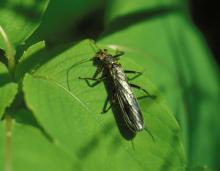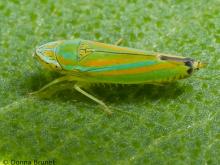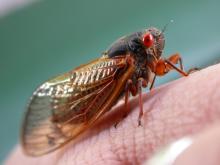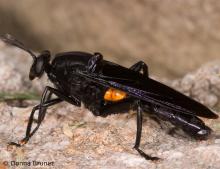Land Invertebrates
Media
Species Types
Scientific Name
Sphecius speciosus
Description
The eastern cicada-killer wasp might be the scariest-looking wasp in our state. But it is not aggressive to people and is virtually harmless, unless handled roughly. Like other ground-nesting wasps, nests can be recognized by the mound of earth excavated by the female.
Media

Species Types
Scientific Name
About 300 species in North America north of Mexico
Description
People notice spider wasps when they notice a female lugging a captured spider to its doom. In most cases, she will drag the spider into a burrow, lay an egg on the spider, and then hunt for more spiders!
Media

Species Types
Scientific Name
Three genera: Sceliphron, Trypoxylon, and Chalybion
Description
Mud daubers are among the most familiar solitary wasps. They belong to a number of related groups, but we call them all "mud daubers" because they all build their nests out of mud. One way to tell the different mud daubers apart is by the distinctive architecture they use.
Media

Species Types
Scientific Name
Nearly 500 species in North America north of Mexico
Description
Velvet ants are not true ants. True ants are social insects, while velvet ants are a group of solitary wasps. Female velvet ants are wingless throughout their lives; males are winged.
Media

Species Types
Scientific Name
Tabanus, Chrysops, and related genera
Description
Meet the horse fly: Stealthily, one will land on your back, slice your skin, and lap your blood. By the time it starts to hurt and you swat at it, the painful, itchy welt is rising.
Media

Species Types
Scientific Name
About 1,500 species in North America north of Mexico
Description
Adult caddisflies are mothlike. Their larvae are aquatic and build portable, protective cases out of local materials, including grains of sand, bits of leaves and twigs, and other debris.
Media

Species Types
Scientific Name
Nearly 700 species in North America north of Mexico
Description
Stoneflies have a lot in common with mayflies, caddisflies, dragonflies, and dobsonflies: They begin life as aquatic larvae, then molt and become winged adults. Many fish find stoneflies irresistible, and anglers know it.
Media

Species Types
Scientific Name
More than 3,000 species in North America north of Mexico
Description
The leafhoppers are a large and diverse family of sap-sucking, hopping insects. You can distinguish them from similar groups of hoppers by the hind legs, which have at least one row of small spines on the hind tibiae (“shins”).
Media

Species Types
Scientific Name
Magicicada spp.
Description
Periodical cicadas live as nymphs for 13 or 17 years underground, and then emerge simultaneously to metamorphose into their adult form. Tremendous numbers of periodical cicadas, calling all at once, are a memorable event.
Media

Species Types
Scientific Name
About 80 species in North America
Description
Mydas flies are quite large, and although they resemble wasps, they are harmless. Note that all true flies have only one pair of wings. Also note the clubbed antennae (unusual for flies).
See Also



Media

Species Types
Scientific Name
Cisseps fulvicollis
Description
The yellow-collared scape moth is more often “orange-collared.” And whether you think it looks more like a firefly or a wasp, it’s still a moth!
Media

Species Types
Scientific Name
Nearly 150 species in North America north of Mexico
Description
Slim, delicate plume moths are instantly recognizable by their T-shaped silhouette, long legs, and muted shades of tan and brown. It can be hard to separate the various species.
Media

Species Types
Scientific Name
Pyrrharctia isabella
Description
Not many people know the adult Isabella tiger moth when they see one, but we’re all acquainted with its caterpillar, the woolly worm, or woolly bear.
About Land Invertebrates in Missouri
Invertebrates are animals without backbones, including earthworms, slugs, snails, and arthropods. Arthropods—invertebrates with “jointed legs” — are a group of invertebrates that includes crayfish, shrimp, millipedes, centipedes, mites, spiders, and insects. There may be as many as 10 million species of insects alive on earth today, and they probably constitute more than 90 percent all animal species.





















